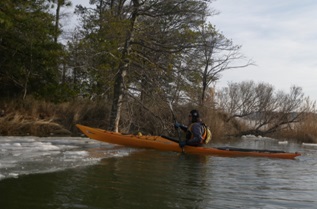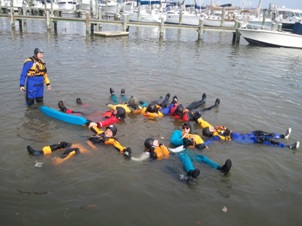First I would like to thank everyone for their support in re-electing me as the Coordinator. I am looking forward to a new year that will include many training events, day trips, car camping and kayak camping. For all of these activities to happen, we will need volunteers to help run these trips and events. Coming this winter we will be having a Navigation Class, and SK 101. Past years we have also had a cold water workshop. Now that winter is here, at least based on temperatures it’s a perfect time to discuss how we can safely continue to paddle.

Cold Water Paddling is here. It can be beautiful, peaceful, and dangerous. With certain precautions, is can also be done safely. There are many resources that provide information on cold water paddling. One of the leading sites is National Center for Cold Water Safety. The center was started by a former member of CPA, Moulton Avery and is an excellent resource for kayak specific information on Cold Water.
Falling into cold water is dangerous in many ways:
Cold Shock is caused by sudden contact with cold water on bare skin. This can induce a gasp reflex and inhalation of water.
Incapacitation involves the progressive cooling of your muscles and nerves to the point where they stop working. Many of us have experienced our fingers going numb when immersed in cold water.
Hypothermia is a drop in deep body (core) temperature, the temperature of your internal organs. This can happen in or out of the water, but cold water immersion accelerates the process.
So how do we minimize our risk when paddling in cold water? Let’s start by minimizing the risk of falling in to begin with. When I paddle in the winter, I tend to paddle in calmer, more sheltered water. In rougher water you tend to get wet from waves splashing over you even without falling in. Wind can also cause more rapid evaporative chilling making paddling in open water more hazardous for many reasons.

Another hazard is ice. While it may seem amusing to paddle up onto an ice shelf, it is possible that the ice may not be consistently strong and could cause one to capsize if a portion of the ice gives way. A capsize at the edge of the ice sheet, may result in the victim being drawn beneath the ice unless able to extract themselves or be rescued by another paddler. Sometimes the waterways can be totally iced in making paddling impossible. On those days, winter hiking is a good option.
Finally, while you may enjoy the serenity and solitude of a solo paddle in the winter, it is safest to paddle with a group. Members of the group should all have the necessary skills and equipment so that everyone stays safe.

Dressing for Immersion–Everyone has heard the term dress for immersion, or dress for the water, not the air. This means that you wear gear that completely eliminates cold shock and delays incapacitation and hypothermia. Prevention of cold shock is done by covering your skin so that it is not contact the cold water. Depending on the water temperatures and your degree of tolerance for cold there are several options.
Wet Suits/Neoprene are best used for moderately cold water (water temperatures in the 50’s and 60’s F), not the extreme cold you find in winter paddles.
Dry Suits/Semi-Dry Suits are designed to keep you dry, or mostly dry. The dry suit is the outer layer that keeps the water out and traps air warmed by your body inside. This will effectively prevent cold shock if you happen to fall in. The drysuit itself does not provide insulation. That is done by wearing moisture-wicking undergarments, followed by heavier insulated layers to retain body heat.
n addition to the drysuit, you also need to consider your hands, feet and head. Cold water in your ears can be very unpleasant. Some paddlers use ear plugs designed to keep water out, but still allowing you to hear. Wool or neoprene hats also offer protection from the cold. Gloves, paddling mittens, or pogies (an open-ended neoprene sleeve that goes over your paddle with an opening for your hand to grip the paddle) can be used. Socks under your drysuit helps keep your feet warm. You may need paddling shoes a size larger to accommodate the extra layers. It’s important not to constrict your extremities to allow for better blood flow so your fingers and toes stay warm. No matter what you choose for cold water paddling clothes, you should always test your gear. CPA has offered a group cold water swim your gear during our Cold Water Workshops in previous years. This allows you to safely test you cold water gear and find out what works and what doesn’t work. I have discovered that what I though was a dry suit was in reality a damp suit based on a swim test.
You should also practice rescues in your cold water gear. It can be more cumbersome to reenter a kayak in a dry suit. I once discovered that I needed to take my hands out of my pogies to roll or to inflate a paddle float. I didn’t have the fine control of the blade angle that I needed to roll. If you don’t want to do rescues in cold water, at least bring your gear to a pool session and test everything there.
Selecting What to Wear—How do you decide exactly what to wear on a particular paddle? There are lots of factors to consider. First, cold weather comes in a variety of combinations. When there is cold air, cold water, possible wind, etc. the choice is easy…dress for immersion in cold water. This means a dry suit with adequate insulation layers, head and hand protection. You should have tested your clothing before going paddling. While the likelihood of capsizing may be low, consequences of being in the water are very high.
The real dilemma is warm air, cold water. There is not only a risk of cold water immersion, there is also a risk of overheating. This is when you might want to consider a few other factors. How cold is the water? You can take a thermometer and check the actual water temperature where you are paddling. I consider water temperatures in the low 50’s to be the cut off point for when I wear a drysuit, even if I don’t think the likelihood of a swim is high. When the water is over 50o F I also consider the likelihood of swimming. What is the probability of capsizing (it’s never zero)? How reliable is my roll (unless you practice in cold water, sudden immersion can cause some disorientation and may reduce your ability to roll but then it’s never 100 percent). Are there good rescue resources, either a rapid self-reentry (that you practiced in colder water or good group assisted rescues)? If the likelihood of an extended swim is relatively high, dress more for the water than the air.
No matter how you choose to dress, you should have extra warm dry clothes with you in a dry bag. I also bring a storm cag, an extra layer that can go on top of all my gear as additional wind protection and to trap an extra layer of air that stops evaporative cooling.
To make these decisions easier, I mapped out some of my common decision points (see flow chart).
To summarize, cold water paddling can be beautiful, quiet, and an enjoyable experience. It can also be deadly. Making educated decisions regarding where and when to paddle, and how to dress for the environment is the best way to safely paddle through the winter.
Paula Hubbard, Coordinator
